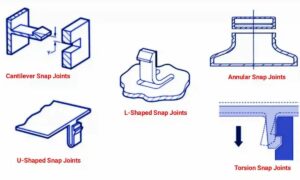I am going to talk about Snap Fit in which you will learn a complete overview of Snap Fit such as their types, design guidelines, common problems during design, and many more.
Snap fit is a mechanical joining technique that involves the use of specially designed protrusions and indentations in two mating components that interlock when the parts are pressed together, creating a secure and reliable fastening without the need for additional hardware such as screws, adhesives or clips.
Snap fits are commonly used in the manufacturing of plastic parts and can provide significant cost savings in assembly and production.
They are widely used in industries such as automotive, electronics, consumer goods, and medical devices. The snap fit design can vary based on the type of application and the materials being used, and can range from simple and flexible to more complex and rigid.
What is Snap Fit?
Snap fit is a type of mechanical fastening method used to connect two components together without the need for additional hardware such as screws or adhesives.
It involves the use of specially designed features on the mating surfaces of the components that interlock when they are pressed together, creating a secure and reliable connection.
Snap fits are commonly used in the manufacturing of plastic parts and can provide significant cost savings in assembly and production.
The design of a snap fit can vary depending on the application and the materials being used, and can range from simple and flexible to more complex and rigid.
Types of Snap Fit
There are several types of snap fit commonly used in the manufacturing of plastic parts. Here are a few examples:

Cantilever snap fit
This is the simplest and most common type of snap fit. It involves a flexible beam (cantilever) on one component that is deflected and inserted into a snap feature on the mating component.
Annular snap fit
This type of snap fit uses a ring-shaped protrusion on one component that snaps into a corresponding groove or recess on the mating component. Annular snap fits provide a stronger connection than cantilever snap fits and can also provide better alignment.
Torsion snap fit
In this type of snap fit, the two mating components are twisted relative to each other to lock into place. Torsion snap fits are often used in applications where a strong connection is required.
Diaphragm snap fit
This type of snap fit uses a thin, flexible diaphragm on one component that is pushed into a snap feature on the mating component. Diaphragm snap fits are often used in applications where repeated assembly and disassembly is required.
Snap hinges
This type of snap fit uses a living hinge to provide a snap fit connection that can rotate. Snap hinges are often used in applications such as lids or enclosures.
The specific type of snap fit used will depend on the requirements of the application, including the materials being used, the size and shape of the parts, and the forces that will be applied to the joint.
Snap Fits Design Guideline
Here are some general guidelines to consider when designing snap fits:
Material selection
Snap fits are commonly used with plastic components, so it’s important to select materials with suitable properties such as stiffness, strength, and durability.
Tolerance and clearance
It’s important to consider the tolerance and clearance between the snap features on the mating components to ensure proper fit and alignment. Generally, a clearance of around 10-20% of the thickness of the component is recommended.
Snap feature design
The snap features on the mating components should be designed to ensure proper engagement and disengagement. The snap feature should have a suitable draft angle to allow for easy insertion and prevent stress concentration.
Cantilever beam design
If using a cantilever snap fit, the beam should be designed with sufficient thickness and length to provide the necessary flexibility and strength.
Stress analysis
It’s important to perform stress analysis on the snap fit design to ensure that the components will not fail under the expected load conditions.
Testing
Prototype testing is recommended to verify the snap fit design and ensure that it meets the requirements of the application.
Manufacturing considerations
The snap fit design should be optimized for efficient and cost-effective manufacturing, with considerations such as ease of assembly, tooling requirements, and part orientation during molding.
